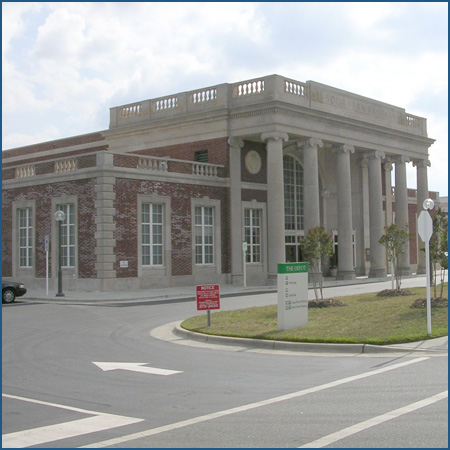()
Known as the J. Douglas Galyon Depot, the station reopened in 2005 following an extensive rehabilitation. The soaring waiting room features a mural of the 1920s Southern Railway network.

Annual Ticket Revenue (FY 2023): $5,737,279
Annual Station Ridership (FY 2023): 157,429
- Facility Ownership: City of Greensboro
- Parking Lot Ownership: City of Greensboro
- Platform Ownership: North Carolina Railroad
- Track Ownership: Norfolk Southern Railway/North Carolina Railroad
Todd Stennis
Regional Contact
governmentaffairsnol@amtrak.com
For information about Amtrak fares and schedules, please visit Amtrak.com or call 1-800-USA-RAIL (1-800-872-7245).
The Greensboro passenger station, now referred to as the J. Douglas Galyon Depot, reopened on October 1, 2005. The grand building was originally erected by the Southern Railway in 1927 to serve it and the Atlantic & Yadkin Railroad. At its peak in the 1940s, more than 40 passenger trains came through the station daily. Designed by the New York architectural firm of Fellheimer and Wagner, the station has a main waiting room with an impressive mural of the Southern Railway network during the 1920s. A pedestrian tunnel extends from the waiting room, under the tracks and up to the train platforms.
Following the decline of passenger railroading after World War II, the station was closed in May 1979; Southern subsequently donated it to the city. From then until 2005, rail passengers waited for the train in a small freight railroad office several miles west of downtown. The North Carolina Department of Transportation and city of Greensboro began working together in 1993 on plans to return passenger rail service to the original station and improve connections with other modes of transportation.
Restoration included reconfiguring a portion of the tracks near the station, extending the former passenger tunnel, and building a new baggage tunnel, boarding platforms and canopies for train passengers. Modernizations included track side escalators and digital arrival/departure monitors; significant effort was made to retain the original 1920s appearance of this beautiful station.
Construction of Phase I began in summer 2001 and was completed in summer 2003. During the first phase, crews restored the lower level train passenger service areas and converted the upper level baggage handling areas to waiting areas for Greensboro Transit Authority city buses and Piedmont Authority for Regional Transit (PART) regional buses. The nearby building formerly used by the Railway Express Agency now houses intercity bus service. During Phase II crews worked on the interior of the depot for Amtrak service, reconstructed the pedestrian tunnel, passenger platforms and canopies and constructed a new baggage tunnel. Work began in fall 2003 and was completed in October 2005. Federal Transit Administration, Federal Highway Administration, state and city funds paid for the $32 million project.
Greensboro was named for Major General Nathanael Greene, commander of the American forces at the Battle of Guilford Court House in 1781. The town was established near the center of Guilford County, planned around a central courthouse square in 1808 to succeed the nearby town of Guilford Court House as the county seat.
In 1840, Greensboro was selected by request of the then-Governor Morehead for inclusion on a new railroad line. The city grew substantially due to its role as a transportation hub for mill villages around the city. In the 1890s, the city continued to attract attention from northern industrialists, including Moses and Caesar Cone of Baltimore; the Cone brothers established large-scale textile plants, changing Greensboro from a town to a city within a decade. By 1900, Greensboro was considered a center of the southern textile industry, with large scale factories producing denim, flannel and overalls.
Greensboro remains a major textile headquarter city, with the main offices of several major textile groups still there. It is also the corporate headquarters of Lorillard Tobacco Company, AIG United Guaranty, Volvo Trucks of North America and others. Rail traffic continues to be important to the city, as it serves as a major regional freight hub as well as a major passenger stop.
The Piedmont and Carolinian services are financed primarily through funds made available by the State of North Carolina.
Features
- ATM not available
- No elevator
- No payphones
- No Quik-Trak kiosks
- No Restrooms
- Unaccompanied child travel not allowed
- No vending machines
- No WiFi
- Arrive at least minutes prior to departure
Baggage
- Amtrak Express shipping not available
- No checked baggage service
- No checked baggage storage
- Bike boxes not available
- No baggage carts
- Ski bags not available
- No bag storage
- Shipping boxes not available
- No baggage assistance
Parking
Accessibility
- No payphones
- No accessible restrooms
- No accessible ticket office
- No accessible waiting room
- No accessible water fountain
- No high platform
- No wheelchair
- No wheelchair lift
Hours


 Amtrak established the Great American Stations Project in 2006 to educate communities on the benefits of redeveloping train stations, offer tools to community leaders to preserve their stations, and provide the appropriate Amtrak resources.
Amtrak established the Great American Stations Project in 2006 to educate communities on the benefits of redeveloping train stations, offer tools to community leaders to preserve their stations, and provide the appropriate Amtrak resources. For more than 50 years, Amtrak has connected America and modernized train travel. Offering a safe, environmentally efficient way to reach more than 500 destinations across 46 states and parts of Canada, Amtrak provides travelers with an experience that sets a new standard. Book travel, check train status, access your eTicket and more through the
For more than 50 years, Amtrak has connected America and modernized train travel. Offering a safe, environmentally efficient way to reach more than 500 destinations across 46 states and parts of Canada, Amtrak provides travelers with an experience that sets a new standard. Book travel, check train status, access your eTicket and more through the